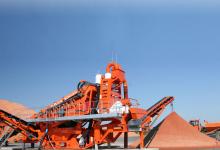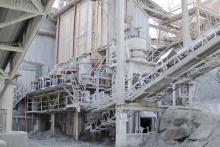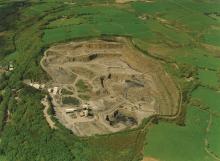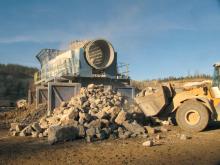
Aggregates Institute’s forthcoming workshop on manufactured sand is ideal for forward-thinking, innovative quarry operators and contractors. Below, workshop presenters Barry Hudson and Hugo Pettingell discuss its key content.
There is natural sand, there is crusher dust, and in-between there is ‘manufactured sand’ of varying, but almost always dire, effectiveness. Concrete producers want the first, aggregate producers want to dispose of large quantities of the second, and almost nobody seems to understand how the third differs from either of the others.
Aggregates Institute, in cooperation with Aggregates Business Europe, is pleased to announce its first UK workshop on Manufactured Sand.
Attendees will take away state-of- the-art test methods that are both inexpensive and robust, for correct characterisation of machine-made sands, including the opportunity to bring their own samples and have their own product evaluated, and will be able to discuss their materials and processes with specialists.
The workshop will cover:
• Characterisation of machine-made sands
• Shortcomings of existing test methods
• Introduction to effective testing procedures
• Selection of appropriate process to correct deficiencies
• Guidance on the application of manufactured sands in concrete
• Reprocessing existing materials or introducing a new stage in a process
• Free access to proprietary online characterisation and quality control systems
The fee for this two-day workshop is set at a level comparable to the cost of one set of conventional analyses in a commercial laboratory, so for an aggregate supplier needing to make a product marketable, or a concrete producer looking for a cost-effective alternative to existing supplies, this workshop will be both enlightening and profitable.
The workshop will be limited to 20 attendees on a first-come basis. To be held on Tuesday and Wednesday 26/27th July 2016 in the London area, it will be facilitated by internationally-recognised and published specialists. Aggregates Institute is an independent body and has no commercial connection with any supplier. Its opinions and evaluations are based on our (workshop presenters Barry Hudson and Hugo Pettingell’s) practical experience and successful project implementation over three decades, combined experience covering over 200 installations worldwide, and participation in some of the leading academic research. We have been involved in applications in the Americas, Europe, Asia, Africa and Australasia.
Central to the workshop is the realisation that conventional evaluation methods do not identify the key characteristics that make or break a machine sand in concrete. The workshop will deal with:
• Current sand specifications - how relevant are they?
• Requirements of concrete producers, pumpers, and finishers.
• Importance of particle shape in different size fractions
• Relevance of particle size distribution
• Identification of the properties of fines
• Leading edge test methods
• Matching processing to material
• Manipulating PSD
• Crusher Selection
• Screening and classification
• Online database and analysis of client’s information for characterisation and production
The aggregate industry typically has branded any crushed product that is less than 4 mesh (4.75 mm) as “manufactured sand”. This of course is not the case. ‘Manufactured sand should be a product that you have intentionally produced, not merely the waste fraction of a process that is targeting larger aggregate sizes’ (Hudson B.P. 2002 ICAR Symposium).
We reproduce this quotation (given in a conference speech by Barry Hudson) to argue that not much has changed in the fifteen years since it was written: Quarries are still trying to palm off crusher dust - sometime after spending a great deal of money fruitlessly washing it - onto ready-mix units that still don’t want it, but are forced to consider it because it’s so cheap.
To produce sands from crushed rock, whether to replace ever-dwindling supplies of naturally-occurring sands, or simply to reduce the huge amounts of unsaleable crushed rock fines generated in many quarries, there are several key characteristics with which we should be concerned, all of which will be discussed fully during the workshop.
Those related to the suitability of the source rock, perhaps best loosely described as chemical properties, may be addressed by using admixtures in the concrete-making process, but, apart from the elimination of certain specific size ranges in which deleterious material may be concentrated, there is little the crushing and sizing process can do. Other factors, however, are well within the influence of existing process technology, and chief among these are particle size distribution, shape, and surface texture.
The particle size distribution of machine-made sand is controlled by screening or sometimes by other methods of classification, the latter usually involving water, which brings its own problems. The pros and cons of wet and dry processes will be fully covered.
Until recently, the grading was usually governed to a great extent by the output of the crusher(s), and the breaking characteristics of the rock, but in the last few years more interest has been shown in means of modifying the natural pattern of breakage, in particular to increase the sub-1mm particle population at the expense of coarser sizes, in order to improve packing density in concrete mixes.
The classification process has no effect upon either particle shape (or indeed on surface texture, as this is a property of the parent rock), so it is necessary to impose improvement with the use of suitable processing: Traditional rock crushers, whether compression (cone) type, or impact (blow-bar or hammer) type, can be made to produce adequate shape in coarse aggregates, but typically product below about 6mm (¼in) contains a high proportion of flaky or elongated particles, resulting in many of the problems inherent in using such material as a sand substitute. Grain shape is a function of the crushing process (and, of course, the natural cleavage and fracture characteristics of the parent rock). Suitable shape is generally described, unhelpfully, as cubical, the ultimate expression of which would be a shape enclosed by six identical square faces. In contrast, we should try to produce a shape that has good volume to surface area ratio, and an easily-packed form, to minimise the amount of binder we need to stick it together in the form of concrete. Given these attributes, it will automatically tend to assist workability, unlike our cube! The ideal form can perhaps be described as equi-dimensional, and without sharp corners and edges. Strangely for such a vital characteristic, there is no universally recognised method of measuring it, but the workshop will demonstrate a simple method for doing so.
Machine sand need not mimic the natural product – in fact it can have some advantageous properties entirely due to its dissimilarity to natural sands. For instance, natural sands must have nearly all of the microfines (which would otherwise be beneficial) removed because of what they might contain, where there is normally no reason for such restriction on crushed rock: The perception that machine-made sand increases water demand in concrete is not necessarily true. During the workshop, an inter-active session will explore the difference between high water demand and admixture affinity of the sand. Much successful research has been carried out on the inclusion of high levels of microfines in machine sand (but rarely adopted in practice as yet). The identification and quantifying of deleterious content in microfines by a simple test will be demonstrated.
And while none of the above is new, there still is a general reluctance, in Europe at least, to invest in equipment or processes, and quarries still want to “lose” their most costly product at low prices to concrete customers that hate the stuff but can’t afford to ignore it. We could do so much better.









